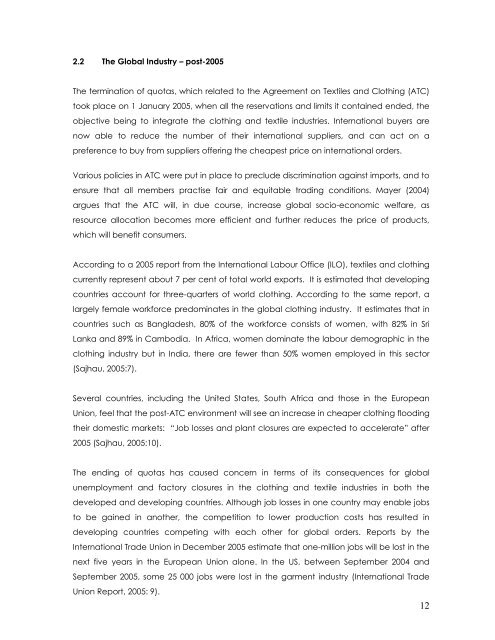Create successful ePaper yourself
Turn your PDF publications into a flip-book with our unique Google optimized e-Paper software.
2.2 The Global Industry – post-2005<br />
The termination of quotas, which related to the Agreement on Textiles and Clothing (ATC)<br />
took place on 1 January 2005, when all the reservations and limits it contained ended, the<br />
objective being to integrate the clothing and textile industries. International buyers are<br />
now able to reduce the number of their international suppliers, and can act on a<br />
preference to buy from suppliers offering the cheapest price on international orders.<br />
Various policies in ATC were put in place to preclude discrimination against imports, and to<br />
ensure that all members practise fair and equitable trading conditions. Mayer (2004)<br />
argues that the ATC will, in due course, increase global socio-economic welfare, as<br />
resource allocation becomes more efficient and further reduces the price of products,<br />
which will benefit consumers.<br />
According to a 2005 <strong>report</strong> from the International Labour Office (ILO), textiles and clothing<br />
currently represent about 7 per cent of total world exports. It is estimated that developing<br />
countries account for three-quarters of world clothing. According to the same <strong>report</strong>, a<br />
largely female workforce predominates in the global clothing industry. It estimates that in<br />
countries such as Bangladesh, 80% of the workforce consists of women, with 82% in Sri<br />
Lanka and 89% in Cambodia. In Africa, women dominate the labour demographic in the<br />
clothing industry but in India, there are fewer than 50% women employed in this sector<br />
(Sajhau, 2005:7).<br />
Several countries, including the United States, South Africa and those in the European<br />
Union, feel that the post-ATC environment will see an increase in cheaper clothing flooding<br />
their domestic markets: “Job losses and plant closures are expected to accelerate” after<br />
2005 (Sajhau, 2005:10).<br />
The ending of quotas has caused concern in terms of its consequences for global<br />
unemployment and factory closures in the clothing and textile industries in both the<br />
developed and developing countries. Although job losses in one country may enable jobs<br />
to be gained in another, the competition to lower production costs has resulted in<br />
developing countries competing with each other for global orders. Reports by the<br />
International Trade Union in December 2005 estimate that one-million jobs will be lost in the<br />
next five years in the European Union alone. In the US, between September 2004 and<br />
September 2005, some 25 000 jobs were lost in the garment industry (International Trade<br />
Union Report, 2005: 9).<br />
12
















